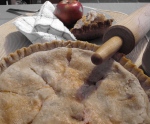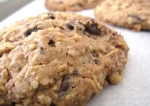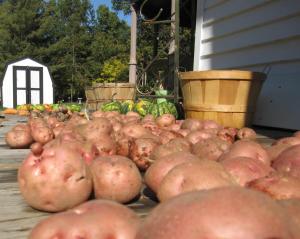Hi folks. Remember me? I know, I know. It has been a bit of time. But, I’ve been here all along….. just apparently really “messy” over the holidays, as things keep falling off my plate….including this blog. 😦
Today, I’m sharing my pet with you. Sourdough starter. This pet (or rather these million pets, a combination of beneficial yeasts and bacteria, if you are feeling technical) is easy to keep. You just have to remember to feed. I call mine Sally and she lives in my refrigerator in a half-gallon blue Ball jar.
I have literally shared Sally by giving some of the starter to guests who had an intense interest in sourdough bread. But since attempting to send the real thing to you via electronic signal might get a little messy …. especially for my computer … I hope you’ll be ok with sharing Sally via blog.
I’m somewhat of a sourdough snob in that I believe that sourdough bread should be comprised entirely of my own cultured yeast. Most recipes you find these days call for part sourdough starter and part commercial yeast.
Soon, in this Bygone Basics blog, you will get a recipe for Sourdough bread. I am giving you time to get your own pet in the refrigerator….ready to make bread.
Ever hear the old adage, “there’s more than one way to skin a cat”? There is more than one way to start your own culture. Some include potatoes, some take much longer…
Here’s a basic flour and water way:
- Make a paste with 1/2 c flour (unbleached/bread if you can) and 1/2 c water. Loosely cover and leave at room temperature for 1 day.
- Stir in another 1/2 c flour and 1/c water. Loosely cover and leave at room temperature.
- On the third day, it will smell a bit sour and be a bit bubbly. Stir in another 1/2 c. flour and 1/2 c. water. Loosely cover and leave at room temperature.
- On the fourth day….you may get the drill by now…. Stir in the 1/2 c. flour and 1/2 c. water. Cover and leave at room temperature. You should be seeing some clear evidence of the yeast “working”.
- On the fifth day, you should have a bubbly, fermented, pungent mass. You have just given birth to your own Sally! If it looks like it isn’t frothy and yeasty, leave it out another day…it could be your home wasn’t warm enough to encourage the growth in 5 days. Once, I was making it for someone and it took about 9 days at room temperature to get a thick bubbly mass.
Another method…think “Easy Button” to borrow a phrase ….is this:
Mix 2 c. warm water (not over 115 degrees F) with a packet of active dry yeast. Then stir in 1 1/2 c. flour. Cover loosely and leave in a warm (not hot) place overnight. It should be a frothy mass, but will not yet have the pungent, alcohol-ly, smell and depth of quality and flavor (some things are best taking the slow-road for). At this point treat just as I describe above (as if it was the fifth day). It is usable as sourdough starter and will develop the same depth of flavor and taste over time as it ferments in the refrigerator. Don’t forget to feed her!

I just fed Sally. I leave her out of the ‘fridge for an hour to ensure feeding. I feel better knowing my pet is alive and the little bubbles tell me she’s doing just fine.
Regardless of how you start Sally, she will live indefinitely as long as you don’t starve her. Her flavor will evolve based on the flours you use and even the wild yeasts that are present in your environment. She will become, one of a kind, YOURS over time.
You can now make bread with her. It is time to store her in the refrigerator. She’ll live in there for 7 to 10 days. Then, if you haven’t used some and refreshed her, you need to feed Sally. Just take out a cup of the starter to make room for the “feed” and add in a 1/2 c. flour and 1/2 c. water (sound familiar?) Every 2 or 3 feedings, I add a tablespoon of honey; and swap the white flour for whole wheat or…another flour every several feedings….but that’s just what I choose to do.
Do you make sourdough bread? How do your techniques/recipe for starter differ?
Just don’t forget to feed her every week or so…
“I would say to housewives, be not daunted by one failure, nor by twenty. Resolve that you will have good bread, and never cease striving after this result till you have effected it. If persons without brains can accomplish this, why cannot you?” –’Housekeeping In Old Virginia’ Marion Cabell Tyree ed. (1878)
Soon…..a nice recipe for bread using Sally and no commercial yeast.
To really add depth of learning and wonderful memories, you can come the our heritage kitchen here at Bygone Basics to learn heirloom bread-making hands-on…and/or many other heritage home arts… http://www.bygonebasics.com. You can even stay here at our immersion bed and breakfast! www.amandasbequest.com


























